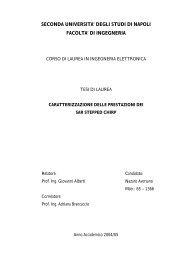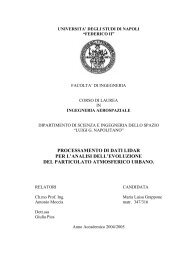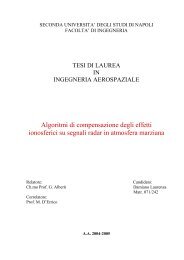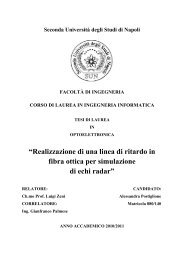Intersatellite link for Earth Observation Satellites ... - CO.RI.STA
Intersatellite link for Earth Observation Satellites ... - CO.RI.STA
Intersatellite link for Earth Observation Satellites ... - CO.RI.STA
Create successful ePaper yourself
Turn your PDF publications into a flip-book with our unique Google optimized e-Paper software.
An <strong>Earth</strong> <strong>Observation</strong> System is mainly composed of two segments (space and ground) connected by a complex<br />
network of communications that permits to manage the operations of the constellation.<br />
Due to the high per<strong>for</strong>mances in terms of imaging capabilities of the imaging system a corresponding high capacity<br />
to download data to ground is needed. To guarantee that the system is able to download to the ground station, in a<br />
proper time, all the images taken from the imager (radar and/or optical) during the mission, ground stations, located<br />
in a polar zone, have been <strong>for</strong>eseen. Polar stations offer a service needed to provide the requested images to the<br />
users in a near real-time manner. An alternative approach is investigated, taking into consideration an intersatellite<br />
<strong>link</strong> system (ISLs) instead of polar stations, in order to permit highly efficient transmission of data towards ground<br />
stations.<br />
ISLs permits a satellite to communicate, when it is not visible from a receiving ground station, using a geostationary<br />
TLC satellite. In particular, optical intersatellite <strong>link</strong> (OISLs) will transfer high volume data between the <strong>Earth</strong><br />
<strong>Observation</strong> (LEO) satellite and a dedicated TLC GEO satellite. Also an optical feeder space to ground <strong>link</strong> has been<br />
considered<br />
II.<br />
Mission Scenario<br />
The general system components are shown in a<br />
figure 1. The communication system allows the<br />
optical <strong>link</strong> between two terminals mounted<br />
respectively on EO satellite which is in a low<br />
earth orbit (LEO) and a dedicate TLC satellite<br />
which is in a geostationary one (GEO), the<br />
distance between the two terminals is about<br />
45,000 km (in the worst case). The mission<br />
scenario <strong>for</strong>esees an optical <strong>link</strong> from LEO to<br />
GEO and an optical <strong>link</strong> and/or RF <strong>link</strong> from<br />
GEO to ground station.<br />
Figure 1. Mission Scenario<br />
III. Simulated operation scenario<br />
An EO System composed of four LEO satellite constellation has been used to per<strong>for</strong>m the following simulation.<br />
Without OISLs <strong>link</strong>, during the operations of EO system the data-takes can only be relayed to the ground<br />
immediately after acquisition only if the satellite is within the range of the receiving stations. Outside their<br />
acquisition zones, the images have to be stored by onboard solid-state memory; the storage device can only dump<br />
data when the satellite is within range of a receiving station.<br />
OISLs is used to send image data via optical <strong>link</strong> to a TLC GEO satellite, this could be done directly or later by<br />
dumping of data from the onboard storage device. With this system it is possible to send the images from EO<br />
satellite to any part of the surface of the <strong>Earth</strong> covered by the TLC GEO satellite.<br />
In the figure 2, an example of the coverage area <strong>for</strong> direct image acquisition, considering an Italian and polar<br />
receiving stations, is shown.<br />
2<br />
American Institute of Aeronautics and Astronautics








